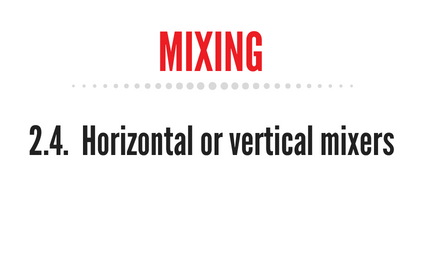Horizontal or vertical mixers

Mixers are performed to evenly blend various kinds of raw material powder and sometimes liquid adding equipment is necessary to be used to add liquid nutrition ingredients for better mixing. We can distinguish between:
1.Horizontal Mixers
-
Continuous ribbon mixers: they consist of a horizontal, stationary, half-cylinder with revolving helical ribbons placed on a central shaft so as to move materials from one end to the other as the shaft and ribbon rotate inside. Capacity can be from a few litres to several cubic metres. The speed of shaft rotation will vary inversely as the circumference of the outer ribbon. Since material travel is from one end to the other, either end may be used for discharge. These mixers may be inverted for cleaning.
-
Non-continuous ribbon mixers: they’re similar to the continuous ribbon mixers except that short sections called "paddles" or "ploughs" are spaced in a spiral round the mixer shaft. An action is different from that of continuous ribbon mixers and may be more satisfactory for mixing liquids with dry solids. These mixers are made in a wide variety of sizes.
2.Vertical Mixers
They consist of a cylinder, cone or hopper-shaped container, with a single or double screw, located vertically through the centre. The screw operates at speeds of 100 to 200 rpm and vertically conveys incoming materials from the bottom end, like a screw conveyor, to the top where they are scattered and fall by gravity. This sequence is repeated several times until a blend is attained (usually from 10 to 12 minutes). These mixers may also be loaded from the top. Results show that vertical mixers are not efficient for uniform mixing of solids and liquids or for materials of quite a different particle size or density. This unit is difficult to clean and there may be inter-batch contamination.
3.Liquid Mixers
Oils and water-miscible oil preparations are often added to dry ingredients as a source of energy or as a specific nutrient. Although the oil-soluble vitamins are available in dry carrier concentrates, liquids containing nutrients can be mixed faster and with more uniformity than the same nutrient in dry concentrate condition. Therefore, a liquid blender may be needed in the feed plant.
Liquid mixers usually consist of a horizontal tub or cylinder with a number of wires or paddles equally spaced around a shaft which revolves inside. Sometimes the shaft is hollow and liquids are forced through holes in the paddles in a spray effect. Some models have a shaft speed of 400 to 600 rpm while others rotate at 1.200 rpm.
New comment